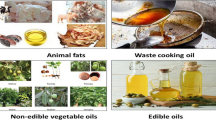Abstract
Microalgae have rich oil production under full photosynthesis, which reaches over 50 mass%. In addition, microalgae oil contains the prolific cis-4,7,10,13,16,19-docosahexaenoic acid that is usually refined for making health food or food additives. This study investigated Aurantiochytrium sp., which is a kind of microalgae, the oil of which is also refined for use in health food or food additives. The solid byproducts of Aurantiochytrium sp. oil are more than 20 mass%, discarded as rubbish. Fortunately, the solid byproducts have been found to contain a large amount of palmitic acid that exceeds more than 67 mass%, but it is difficult to transesterify from the solid byproducts of Aurantiochytrium sp. oil, such as the waste cooking oil or waste engine oil, which contain many impurities. Thus, the impurities, the free fatty acids, and the microalgae cell wall of solid byproducts interfere with transesterification. Sequences of saponification, reduction reaction, and acid-catalyzed reactions were conducted for the full process of transesterification in this study. Gas chromatography analysis, differential scanning calorimetry thermal analysis, and Fourier transform infrared spectroscopy repeatedly corroborated the results of the transesterification, which proved that the solid byproducts of Aurantiochytrium sp. oil form a high-yield and high-quality biodiesel. Overall, we have successfully obtained more than 92 mass% transesterification rates from the solid byproducts of Aurantiochytrium sp. oil. The solid byproducts are waste turned into gold.










Similar content being viewed by others
References
Fedorova-Dahms I, Marone PA, Bauter M, Ryan AS. Safety evaluation of DHA-rich algal oil from Schizochytrium sp. Food Chem Toxicol. 2011;49:3310–8.
Pan XX, Xu L, Zhang Y, Xiao X, Wang XF, Liu Y, Zhang HJ, Yan YJ. Efficient display of active Geotrichum sp. lipase on pichia pastoris cell wall and its application as a whole-cell biocatalyst to enrich EPA and DHA in fish oil. J Agric Food Chem. 2012;60:9673–9.
Pyle DJ, Garcia RA, Wen Z. Producing docosahexaenoic acid (DHA)-rich algae from biodiesel-derived crude glycerol: effects of impurities on DHA production and algal biomass composition. J Agric Food Chem. 2008;56:3933–9.
Wang J, Cao L, Han S. Effect of polymeric cold flow improvers on flow properties of biodiesel from waste cooking oil. Fuel. 2014;117:876–81.
Sivakumar P, Anbarasu K, Renganathan S. Bio-diesel production by alkali catalyzed transesterification of dairy waste scum. Fuel. 2011;90:147–51.
Lee SU, Jung K, Park GW, Seo C, Hong YK, Hong WH, Chang HN. Bioprocessing aspects of fuels and chemicals from biomass. Korean J Chem Eng. 2012;29(7):831–50.
Hayyan A, Hashim MA, Mirghani ME, Hayyan M, AlNashef IM. Esterification of sludge palm oil using trifluoromethanesulfonic acid for preparation of biodiesel fuel. Korean J Chem Eng. 2013;30(6):1229–34.
Hoekman SK, Broch A, Robbins C, Ceniceros E, Natarajan M. Review of biodiesel composition, properties, and specifications. Renew Sustain Energy Rev. 2012;16:143–69.
Tsanaktsidis CG, Christidis SG, Favvas EP. A novel method for improving the physicochemical properties of diesel and jet fuel using polyaspartate polymer additives. Fuel. 2013;104:155–62.
Pullen J, Saeed K. An overview of biodiesel oxidation stability. Renew Sustain Energy Rev. 2012;16:5924–50.
Jain S, Sharma MP. Application of thermogravimetric analysis for thermal stability of Jatropha curcas biodiesel. Fuel. 2012;93:252–7.
Dunn RO. Crystallization behavior of fatty acid methyl esters. J Am Oil Chem Soc. 2008;85:961–72.
Garcia-Perez M, Adams TT, Goodrum JW, Das KC, Geller DP. DSC studies to evaluate the impact of bio-oil on cold flow properties and oxidation stability of bio-diesel. Bioresour Technol. 2010;101:6219–24.
Silva MCD, da Silva LM, Brandão KS, Souza AG, Cardoso LP, dos Santos AO. Low temperature properties of winterized methyl babassu biodiesel. J Therm Anal Calorim. 2014;115:635–40.
Samyn P, Schoukens G, Vonck L, Stanssens D, den Abbeele HV. Quality of Brazilian vegetable oils evaluated by (modulated) differential scanning calorimetry. J Therm Anal Calorim. 2012;110:1353–65.
Rodríguez RP, Sierens R, Verhelst S. Thermal and kinetic evaluation of biodiesel derived from soybean oil and higuereta oil. J Therm Anal Calorim. 2009;96:897–901.
Gundogar AS, Kok MV. Thermal characterization, combustion and kinetics of different origin crude oils. Fuel. 2014;123:59–65.
Li KY, Tsai SY, Lin CP, Tsai YT, Shu CM. Smart technology for evaluating fire extinguishing effect of tert-butyl hydroperoxide. Ind Eng Chem Res. 2013;52:10969–76.
Lin CP, Tseng JM. Green technology for improving process manufacturing design and storage management of organic peroxide. Chem Eng J. 2012;180:284–92.
Tseng JM, Lin JZ, Lee CC, Lin CP. Prediction TMCH thermal hazard with various calorimetric tests by green thermal analysis technology. AIChE J. 2012;58(12):3792–8.
Zhang X, Li L, Xie H, Liang Z, Su J, Liu G, Li B. Effect of temperature on the crystalline form and fat crystal network of two model palm oil-based shortenings during storage. Food Bioprocess Technol. 2014;7:887–900.
Lau Nang HL, Puah CW, Choo YM, Ma AN, Chuah CH. Simultaneous quantification of free fatty acids, free sterols, squalene, and acylglycerol molecular species in palm oil by high-temperature gas chromatography-flame ionization detection. Lipids. 2005;40(5):523–8.
Jo YB, Park SH, Jeon JK, Ko CH, Ryu C, Park YK. Biodiesel production via the transesterification of soybean oil using waste starfish (Asterina pectinifera). Appl Biochem Biotechnol. 2013;170:1426–36.
Man Che YB, Setiowaty G, van de Voort FR. Determination of iodine value of palm oil by Fourier transform infrared spectroscopy. J Am Oil Chem Soc. 1999;76(6):693–9.
Acknowledgements
The authors are indebted to the donors of National Science Council (NSC), Taiwan, ROC under the contract No.: NSC 102-2221-E-468-001-MY2 for financial support. In addition, we are grateful to VEDAN Enterprise Corp. in Taiwan for providing the microalgae oil.
Author information
Authors and Affiliations
Corresponding author
Rights and permissions
About this article
Cite this article
Tsai, SY., Lin, HY., Lu, GY. et al. Solid byproducts of Aurantiochytrium sp. oil made into the biodiesel. J Therm Anal Calorim 120, 563–572 (2015). https://doi.org/10.1007/s10973-015-4437-z
Received:
Accepted:
Published:
Issue Date:
DOI: https://doi.org/10.1007/s10973-015-4437-z




